When we meet with future clients, they usually compare several types of roofing systems. We’re always asked: Which is better? Which is more affordable? Which is best for long-lasting protection?
The Basics
Single-Ply Membrane Roofing
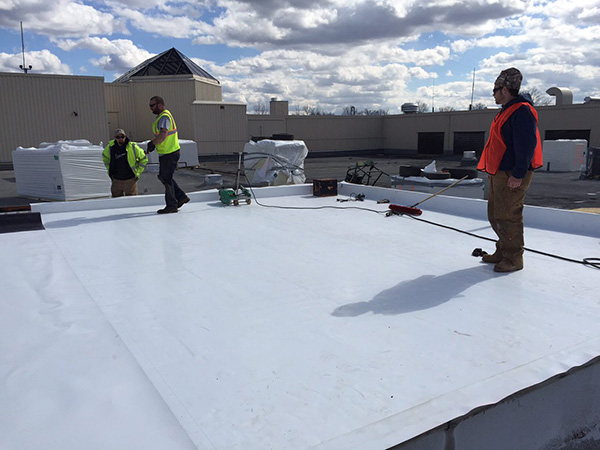
Single-Ply Membranes are sheets of rubber and other synthetics that can be chemically adhered to insulation or ballasted creating a layer of protection on your commercial facility.
There are two main types of single-ply membrane commercial roofing: Thermoplastic Polyolefin (TPO) and Ethylene Propylene Diene Terpolymer (EPDM). They differ in their chemical makeup, how they are installed, and their energy efficiencies.
Read More: Single-Ply Membrane Roofing: Installation & Performance
Spray Foam Roofing
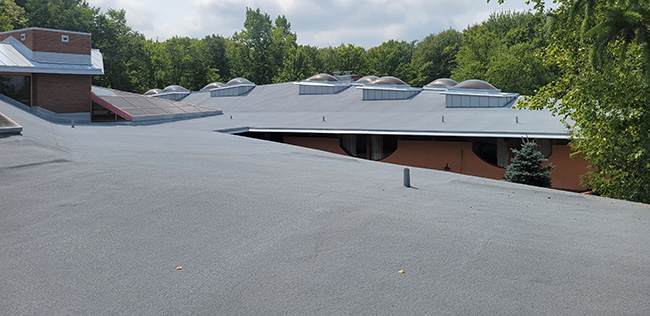
Spray Polyurethane Foam, more commonly referred to as SPF, is a material that’s sprayed and expands into a foam, creating a solid layer across an existing roof.
While spray foam roofing is not the most known type of roofing material, the technology has been around since the early 1960s for industrial, commercial, and residential facilities.
Read More: Spray Polyurethane Foam (SPF) Roofing: Installation & Performance
Cost
Single-Ply Membrane Roofing
For an average 20,000 sq. foot commercial roof, it will usually cost between $6 to $12 per square foot for EPDM and $6 to $12 per square foot for TPO, including materials and labor warranty.
Spray Foam Roofing
For an average 20,000 sq. foot commercial roof, it will usually cost between $6 to $12 per square foot in materials and labor to install a typical spray foam roofing system. This price range covers a foam roof of average thickness and building structure.
Read More: Cost of a Spray Polyurethane Foam Roofing System
Installation
Single-Ply Membrane Roofing
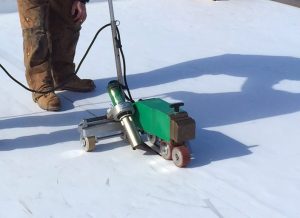
The beginning of the installation process is similar between TPO and EPDM single-ply membrane roofing systems.
After the existing substrate is prepared, either by cleaning or removing the existing roof, the insulation is installed. There are a few types of insulation options the facility manager/owner can choose from Polyisocyanurate (Polyiso), Expanded Polystyrene (EPS), Extruded Polystyrene (XPS)
After the existing substrate is prepared, either by cleaning or removing the existing roof, the insulation layers are installed and covered by a cover board. There are three ways to attach the membrane to the cover board: ballasted, with an adhesive, or mechanically fastened.
The significant difference between TPO and EPDM comes when it’s time to adhere the membrane seams together. TPO uses a hot-air gun to melt down the membrane at the seams and fuse them together. EPDM is joined together with seam tape.
Spray Foam Roofing
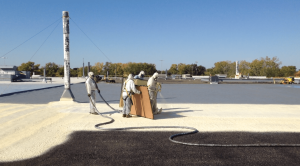
Before the installation can start, the existing roof needs to be prepared. Rather than stripping the existing roof, the contractor will most likely prepare the substrate by getting rid of all dirt, dust, and contaminants.
The first layer put down by the contractor is the polyurethane foam. This foam is created by combining two liquids as it’s sprayed onto the existing roof substrate. As the liquid is sprayed onto the existing roof, it expands to form a solid foam surface.
When the spray foam layer has been completed, it is then coated with a layer(s) of elastomeric silicone or acrylic coating with embedded granules.
Free Download: The Essential Guide to Spray Polyurethane Foam Roofing
Advantages
Single-Ply Membrane Roofing
If properly installed and maintained, a commercial single-ply membrane roof can last 30 years. There are quite a few other benefits of single-ply membrane roofing systems:
- Proven Track Record – EPDM roofing has been used for commercial flat roofing for over 60 years. This amount of time on the market has allowed various laboratory and field studies to be performed and tracked.
- Customer Choice of Insulation – Since single-ply membrane roofing does not include the insulation factor, as a customer, you have more options to choose from to insulate your facility’s roof.
- Class A Fire-Rated – TPO membranes and EPDM can achieve Underwriters Laboratories (UL) Class A fire resistance listings by adding fire retardant chemicals during the manufacturing process.
- Reflective or Retentive – TPO is generally white and highly reflective. On the other side of the spectrum, EPDM is often described as “Black Roofs,” due to the naturally dark color of the membrane.
Read More: Pros and Cons of Single-Ply Membrane Roofing Systems
Spray Foam Roofing
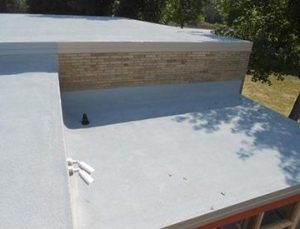
If properly installed and maintained, a commercial spray foam roof can last 50 years. There are quite a few other benefits of SPF roofing systems:
- Energy Efficient – spray foam delivers thermal, air, and moisture barriers to provide the highest R-value per inch.
- Durable – The foam material can expand and contract with the building, decreasing the likelihood of cracks and splitting.
- Seamless and Waterproof – The continuous solid surface does not require joints or seams, removing the most vulnerable area for leaking.
- Environmentally Friendly – In most cases, there is minimal stripping of the original roof – eliminating the need for costly roof tear-offs and waste.
Read More: Pros and Cons of Spray Polyurethane Foam (SPF) Roofing Systems
Disadvantages
Single-Ply Membrane Roofing

While the advantages of a single-ply membrane roofing system outweigh the disadvantages, there are a few things you should keep in mind. Here are the disadvantages of single-ply membrane roofing systems:
- Durability – Single-ply membrane roofing does not have a hard top layer to protect the synthetic rubber from dropped tools, gravel, or loose screws from being pushed into the rubber membrane.
- Seams – Although these seams are sealed either mechanically or with melting adhesives, they are still areas that are more vulnerable to leaks than other roofing systems.
- Roofing Accessories – Penetrations such as skylights or vents need special attention during installation.
- UV Rays – UV rays that shine directly on the roof can degrade the adhesives quickly over time.
Spray Foam Roofing
While the advantages of a foam roof outweigh the disadvantages, there are a few things you should keep in mind. Here are the disadvantages of spray foam roofing systems:
- Hire the Right Professional – The contractor needs to be precise with the application and have a solid understanding of the chemicals they are using.
- Limited Installation Window – Installation cannot be performed during cold, windy, or rainy weather.
- Overspray Potential – Since the foam is installed by a spray application, there is a risk of the wind carrying overspray onto surrounding cars and other surfaces.
- Limited Colors – The silicone coating that is applied to the foam comes in two colors: white and gray.
- Maintenance – foam roofs need to be inspected twice a year at least.
As you can see, both Single-Ply Membrane and Spray Foam Roofing Systems have their benefits and drawbacks. Choosing which one is best comes down to a customer-by-customer basis.


